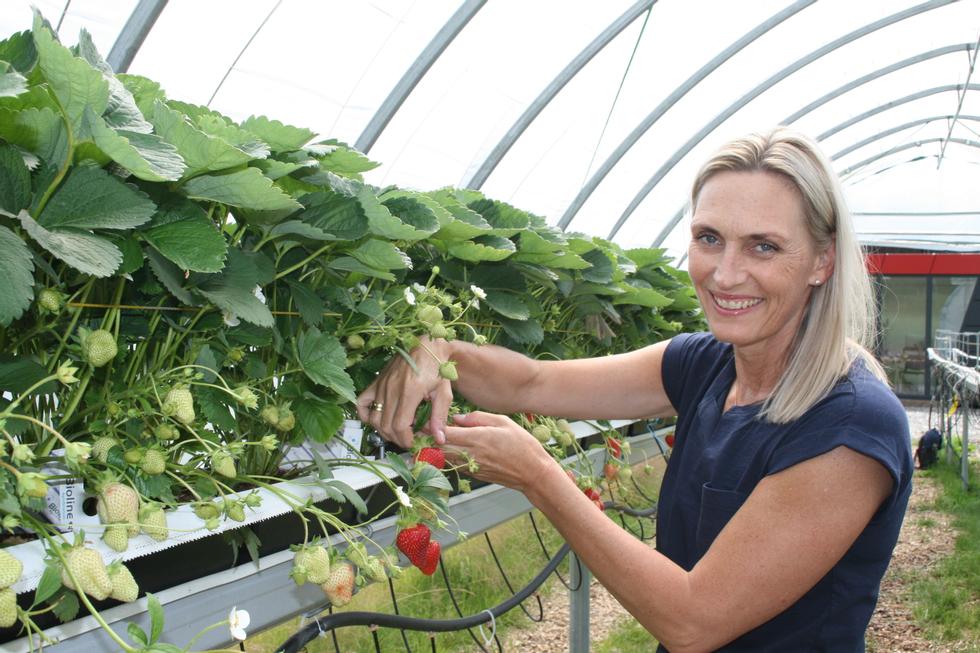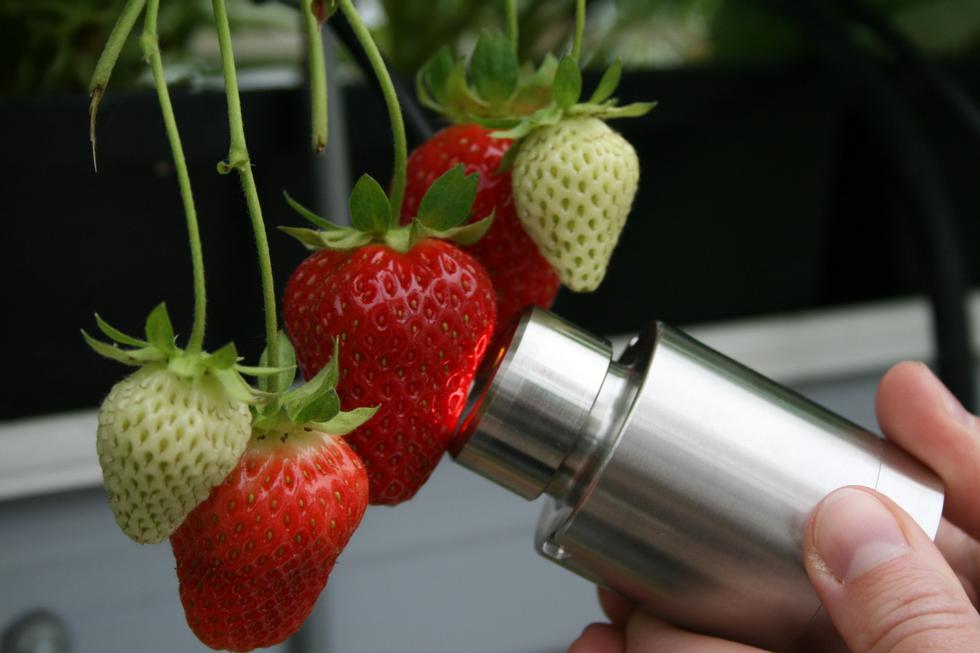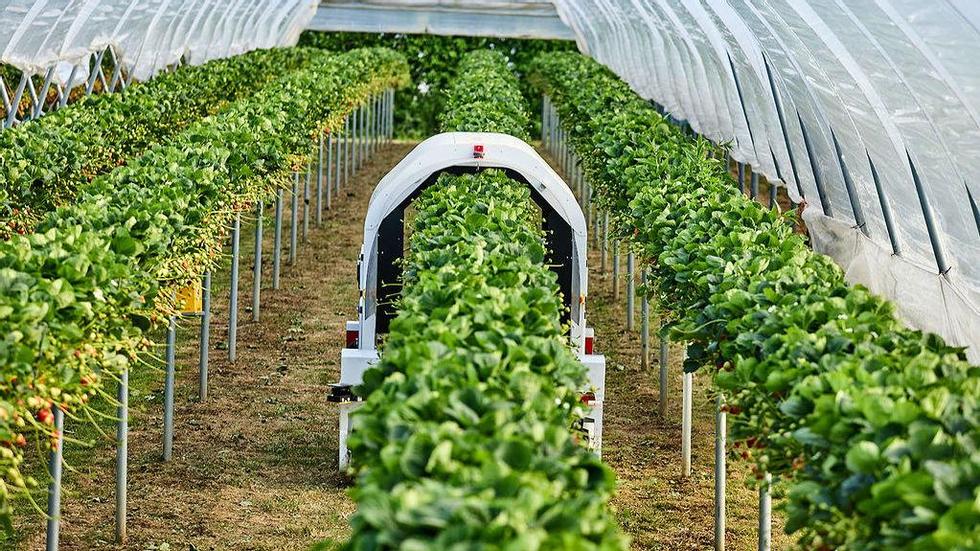He first analyzes the strawberry from a distance to determine if the berries are of interest for further examination. If so, it moves the picking arm toward the berries, then does more in-depth analysis on all sides of the berries before deciding whether or not the berries should end up in the berry basket.
Then it moves to the next berry. He does exactly the same ratings for every single berry, and he never gets bored at work. It can last for hours, yes all day and more, or as long as the battery is there.
But in fact, it is not Thorvald who decides on the choice of berries, because he is not smart. He just does what he’s told by the software in the control system he’s walking around with.
This is the future scenario
─ Well, technologically speaking, we’re not there yet, but that’s the future scenario we’re working on and working on in the innovation project “Sensors for Automated Micro-Picking of Strawberries,” says plant researcher Siv Vagerton Remberg at the Norwegian Life Sciences University, NMBU. . In a press release.
Perfect Picker: Two fruit pickers have different interpretations of what a ripe berry is, even though the starting point and training are the same. But Thorvald on the other hand, would pick perfectly all the time. Photo: Matt Monroe
He has not been completely decapitated
Thorvald does pick berries already, but he has quite a bit of going when it comes to improving selection criteria and choosing the right berries, because so far some unripe berries end up in the basket.
So, this summer and late summer researchers with obsessive interests in detail snuck around shelves with strawberries in the tunnel to gather information and do the analyzes. Because there are many factors that can interfere with what researchers want to record on strawberries when they are hung on the plant. For example, light. So after conducting the analyzes in the Strawberry Tunnel, the researchers put the strawberries into egg cartons to take them with them to the analysis lab, where the berries were analyzed again.
The goal is to see if the measurements made in the strawberry tunnel correspond to those made in the laboratory. Because when researchers do that, they’re one step closer to having Thorvald pick only red and sweet strawberries.
The strawberries in the egg tray must also undergo chemical analyzes to find information about the structure of the berries and the composition of chemicals. Sugar and acid are some of the components that are analyzed.

The Thorvald robot must have good working conditions. Botanist researcher Siv Fägerton-Rumberg and technicians at NMBU make sure of this. Photo: Jean Karen Brodin
Biology and technology together
Saga Robotics owns the project and Thorvald, they also know the technology and robotics. But to succeed, Thorvald and his strawberry plants must play together.
─ We at NMBU know plant biology and plant production, and together with Saga Robotics we decided to investigate how to develop the strawberry picker further, says Remberg.
The team included researchers from the Nofima Food Research Institute who contribute, among other things, to chemical analyzes and taste plates, and the SINTEF Research Institute who are involved in developing the sensors that will improve Thorvald’s actual picking unit.
We are a great group working well together, and this is a good start for further cooperation in factories, quality, production and technology.
Fresh, ripe strawberries all summer long
In the strawberry tunnel, ripe berries are present all summer, from May to September. Strawberries with so-called short day plants are usually produced outdoors in Norway. The plants form flower buds in the fall and then flower and produce berries for four weeks the following year.
Mur The Murano cultivar, which we grow in the tunnel here, is a recurring cultivar that blooms and bears berries as long as the temperature is high and the days are long. The type of plant is called a long-lived plant, and it was originally made for use in lamps, such as those hanging on people’s balconies, says Remberg.
This means that there are berries at all times in all stages of plant maturity, from flowers to ripe berries. In addition to this challenge, Thorvald also has requirements for how the plant should be, and he doesn’t like bunches of berries. But the Murano plant has tall flower stalks that hang down from the plant, which are suitable for Thorvald’s picking arm.

Researchers are performing NIR measurements on berries to check if signals of sugar content can be picked up a few millimeters away in the berries. Photo: Jean Karen Brodin
New interest in how the strawberry plant really works
As botanists, the task of NMBU researchers and technicians is, among other things, to produce berries. In connection with Thorvalds’ entry into strawberry production and research project, strawberry plant physiology, and how the plant works, has also gained increasing attention.
─ One of my research colleagues does basic work investigating how this particular type of plant reacts to a short day, a long day, and different temperatures during growth and development, and we see that it is not always completely A4, says Remberg.
The impression was that this type of plant could produce berries evenly all the time, but had crop tops during the season. The plants probably need to recover and use energy to form flower buds, among other things.
Advice on the best conditions for Thorvald
Thorvald must have good working conditions, both in terms of access to berries and of good quality.
─ So we keep plants in good condition and provide pollination, fertilizing and watering.
Tunnel production is an entirely different production from outdoor cultivation, and requires, for example, irrigation, fertilization, and plant protection measures compatible with the production. Because the plant has flowers, maples, and ripe berries all at the same time, plant protection measures are more of a challenge than producing short day strawberry plants in the open.
But the method of cultivation also has its advantages, because when plants are grown in a shelf and not in the ground, they are not exposed to soil diseases. And in the face of pests, researchers introduce such measures as beneficial animals, for example, predatory mites are used against spider mites.
Pathogenic, downy gray mold easily spreads in strawberries at high humidity. Therefore, an extra effort should be made to clean the plants and remove the parts of the plant that are beginning to get gray mold to reduce the infection pressure in the tunnel.
─ It is important to make sure that it does not become too dense in number of plants, and make sure that it dries up between plants. Next, Thorvald must chop and pick the ripe berries so they don’t rot, says Remberg.
Gray mold fungus can spread quickly in the field if you do not remove overripe berries that are vulnerable to infection. It is important to have a good plant culture to prevent the fungal disease from establishing itself in the strawberry field.
In addition to growing the highest quality berries as a service for Thorvald, the plant ecology of the NMBU also records crop size, berry stability and quality analyses.
─ There is great interest in learning more about this type of strawberry plant in such productions, says Remberg.
Customer wants red and sweet berries
Accurate multiplication as the amount of fertilizer and watering is of great importance to how the berries taste. And taste and color are important to the customer.
─ We have discussed what are the best parameters to work with on this project, which characteristics of the berries are most important for telling Thorvald when to harvest it. We came to the conclusion that color is the most important first and foremost, but of course internal quality such as sweetness and hardness are also important characteristics, says Remberg.
This is where the researchers at Nofima and SINTEF come in. Because if the degree of maturity, sugar content and other parameters can be programmed into the Thorvald console, there are many measurements to calibrate which quality the pickup lever should choose.
Color can be measured from the outside of the berries. This is why SINTEF is working on creating sensors that can distinguish between shades of different colours. But before the sensors can be made, several chemical measurements must be made, during which the berries are split, which must then be compared with measurements that do not destroy the berries.

Researchers at work. Left Anders Hansen (SINTEF), Siv Fagertun Remberg (NMBU), Jens Petter Wold (Nofima), Peter Vejle Andersen (Nofima), Kjersti Aaby (Nofima). Photo: Jean Karen Brodin
Infrared spectroscopy to search for sugar
Near-infrared, or near-infrared, measurements can measure things like protein, water, fats, and carbohydrates in food without destroying it—that is, without taking a piece of a strawberry to check. Among other things, researchers are testing the NIR technology to measure the components in the berries.
Remberg says the results here are promising.
After the berries have been measured at the NIR where they are suspended, they are picked before the flight goes to Nofima’s egg cartons for further in-depth analyses. The question that needs to be answered is whether it is possible to measure NIR components a few millimeters away in a berry, and where exactly these properties are best measured on a berry.
A palette of taste with trained tastes
At Novima, there is also a trained taste committee. Their job is to taste the strawberries, considering things like sweetness, acidity, greenness, and hardness.
The trained panel and their findings are very valuable in the project, because consumer preferences for the strawberry basket are prominent among Norwegians. In addition, the results are compared with other analysis methods we use in the project, says Remberg.
More accurate than strawberry picker
Those who kneel in the field most of the summer and pick strawberries have learned which berries to pick. But even if they choose as many berries as possible, there will be an individual evaluation of each berry, because they do not spend time comparing the berries of their choice, for example, with the color scheme.
The picker has a preference, but over time it can vary. In addition, two fruit pickers have different interpretations of what a ripe berry is, even though the starting point and training are the same.
But Thorvald on the other hand, would pick perfectly all the time.
The berries should not be touched until they are picked
We’re improving the pickup arm, and we’re working on examining all aspects of the berries, Remberg says.
It is important that the picking arm does not come into contact with the berries if they are not intended for picking, as they can then be damaged.
─ How far the picking arm should be from the berries, and which technique is best suited for judging the berries is one of the things investigated in the project.
Early strawberry in the tunnel
It is about getting to the market with strawberries as soon as possible, which is possible with tunnel production. The tunnel is covered with plastic all year round, and is designed so that water and snow can slide off it. Now the tunnel is outside a field in the NMBU, but it could be anywhere, for example on asphalt.
─ Because plants are on a shelf, it is actually possible to grow them anywhere and just about anything, as long as there is a controlled irrigation and fertilization system that provides water and nutrients to the plants. Almost like a vein, says Remberg.

“Web specialist. Lifelong zombie maven. Coffee ninja. Hipster-friendly analyst.”



